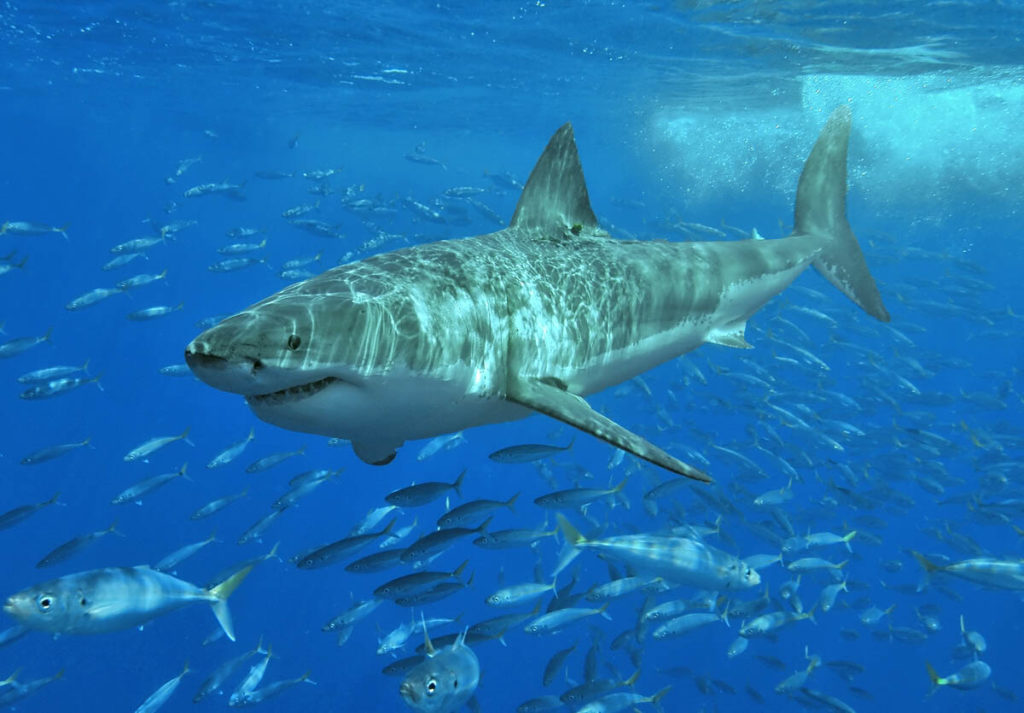“It’s a wonderful thing in science when you have that serendipity moment where you actually see that something is happening that you didn’t predict, you follow up on it and you discover something great. And that’s what we’ve discovered here in Nova Scotia, this remarkable aggregation of white sharks that come here every summer to feed.”
OCEARCH Chief Scientist Dr. Bob Hueter
The waters surrounding Nova Scotia and other Maritime provinces serve as a “feeding aggregation” for great whites, where they spend their summers and fall before heading south. A 3,541-pound shark that’s over 17 feet long and nicknamed “Queen of the Ocean” was spotted in the area last December 2021. Other sharks that are swimming around the province include Rose (10 feet 5 inches, 600 pounds), Bluenose (11 feet 7 inches, 737 pounds), Ironbound (12 feet 4 inches, 998 pounds), Scot (12 feet, 1,644 pounds), Hali (10 feet, 687 pounds), Sable (11 feet 6 inches, 807 pounds).
The great white shark, also known as the white shark, white pointer, or simply great white, is a species of large mackerel shark found in all major oceans’ coastal surface waters. It is notable for its size, with larger females reaching 6.1 m (20 ft) in length and weighing 1,905–2,268 kg (4,200–5,000 lb) at maturity. Males measure 3.4 to 4.0 m (11 to 13 ft) on average, while females measure 4.6 to 4.9 m (15 to 16 ft). According to a 2014 study, great white sharks can live for up to 70 years or more, far exceeding previous estimates, making it one of the longest lived cartilaginous fishes. According to the same study, male great white sharks reach sexual maturity in 26 years, while females reach sexual maturity in 33 year For short bursts, great white sharks can reach speeds of 25 km/h (16 mph) and dive to depths of 1,200 m. (3,900 ft).
The great white shark is an apex predator because it has no known natural predators other than the orca on rare occasions. It is arguably the world’s largest known extant macropredatory fish and a primary predator of marine mammals up to the size of large baleen whales. This shark is also known to prey on other marine animals such as fish and seabirds. It is the only surviving species of the genus Carcharodon, and it is responsible for more recorded human bite incidents than any other shark.
A quarter of all shark, skate, and ray species are on the verge of extinction. The number one threat to sharks in Canada and around the world is overfishing, which occurs when a species or population is fished faster than it can be replenished.

Shark finning is a destructive practice that requires an immediate and strong response to halt its devastating impact on global shark populations. Sharks, as apex predators, play an important role in the health of other fish populations and ocean ecosystems. Shark population declines have a negative impact on our oceans.
The Canadian government is concerned about the global status of endangered shark stocks as a result of destructive and damaging practises such as shark finning. The amendments to the Fisheries Act (2019) are a clear example of Canada’s ongoing commitment to improving the conservation and sustainability of our ocean environment.
About Ocearch
Ocearch is a data-driven organization that was created to assist scientists in collecting previously unattainable data in the ocean while also open sourcing our research and explorations. Open sourcing and inclusion at every level, in real-time, enable the entire world to participate in our projects while staying informed about the evolving science.
According to a quote on Ocearch’s site
“Sharks are Amassing the East Coast” is what a viral tweet stated on December 1, 2021 along with a zoomed out photo of our shark tracker. Is there an unusual amount of sharks actually making their way to the East Coast of the United States and Canada? No. Are there more tagged sharks on the OCEARCH Global Shark Tracker in this region? Yes.







1 Comment
Always said a matter of time…last summer’s gurlbite off Margaree Isle in CB is a portent of things to come…not a fear monger but just saying about how the white shark pop will intersect with humans…I spoke of the shark attack on John Roult (1891 off Halifax) and that was ignored by all the experts…although I learned about it in 1981 while attending SMU. Hell, I was in the water in 1983 not far from wheret hey caught the Alberton giant…lots of shadows that day.